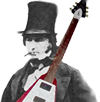Common Open Chord Shapes
Below is a printable sheet of all the most useful chords in open position. Amongst the last few are some barre chords. Be warned, these will require some perseverance!
Notice how each of these chords belongs to one of five ‘shapes’ C, A, G, E and D. This observation will really help to unlock and de-mystify the guitar fingerboard. On one level, the this means that any chord can be played in five different ways, using the shapes of the C, A, G, E, and D chords as templates.
On a deeper level, the importance of the CAGED system for understanding the fretboard is that it helps guitarists to visualize the relationship between chords, scales, and arpeggios. By learning the CAGED shapes, guitarists can easily find the root notes of any chord and build different chord qualities from them. For example, to play a C major chord, one can use the C shape, the A shape, the G shape, the E shape, or the D shape, depending on the position and the sound desired. Similarly, to play a C minor chord, one can modify the CAGED shapes by flattening the third degree of the major scale.
The CAGED system also helps guitarists to play scales and arpeggios in different positions and keys. By knowing the CAGED shapes, one can easily identify the intervals and notes that make up a scale or an arpeggio. For example, to play the C major scale, one can use the C shape, the A shape, the G shape, the E shape, or the D shape, and follow the pattern of whole and half steps that define the major scale. Likewise, to play the C major arpeggio, one can use the same shapes and play only the root, third, and fifth notes of the scale.
The CAGED system is a useful tool for guitarists of any level, as it allows them to explore the fretboard and create their own chord voicings, melodies, and solos. By mastering the CAGED system, guitarists can expand their musical vocabulary and express themselves more freely on the instrument.

